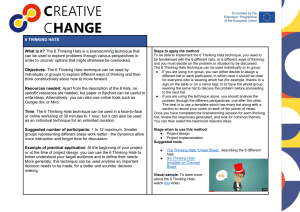6 Thinking Hats
What is it? The 6 Thinking Hats is a brainstorming technique that can be used to explore problems through various perspectives in order to uncover options that might otherwise be overlooked.
Objectives: The 6 Thinking Hats technique can be used by individuals or groups to explore different ways of thinking and then think constructively about how to move forward.
Resources needed: Apart from the description of the 6 hats, no specific resources are needed, but paper or flipchart can be useful to write ideas. Alternatively, you can also use online tools such as Google doc or Miro.
Time: The 6 Thinking Hats technique can be used in a face-to-face or online workshop of 30 minutes to 1 hour, but it can also be used as an individual technique for an unlimited duration.
Suggested number of participants: 1 to 12 maximum. Smaller groups representing different areas work better – the dynamics allow more interaction and longer time for discussion.
Example of practical application: At the beginning of your project or at the time of project design, you can use the 6 Thinking Hats to better understand your target audience and to define their needs. More generally, this technique can be used anytime an important decision needs to be made, for a better and sounder decision making.
Steps to apply the method:
To be able to implement the 6 Thinking Hats technique, you need to be familiarised with the 6 different hats, or 6 different ways of thinking, and you must decide on the problem or situation to be discussed.
The 6 Thinking Hats technique can be used individually or in group:
- If you are using it in group, you can either decide to assign a different hat to each participant, in which case it should be clear for everyone who is wearing which hat (for example, thanks to a sign on the table or on a name tag); or to have the whole group wearing the same hat to discuss the problem before proceeding to the next hat.
- If you are using the technique alone, you should analyse the problem through the different perspectives, one after the other. The best is to use a template which has every hat along with a section to record your notes on each of the points of views.
Once you have completed the brainstorming session for each thinking hat, review the responses generated, and look for common themes. You can then select the best/most relevant ideas.
Stage when to use this method:
- Project design
- Project implementation
Suggested tools:
- The Thinking Hats “Cheat Sheet”, describing the 6 different hats.
- Six Thinking Hats template on Concept Board
Visual sample: To learn more about the 6 Thinking Hats, watch this video.


